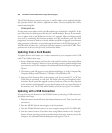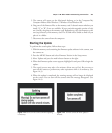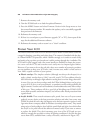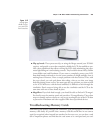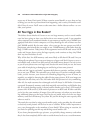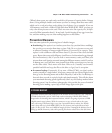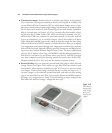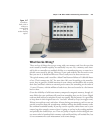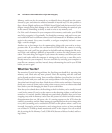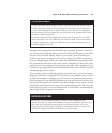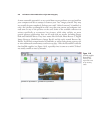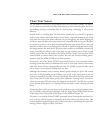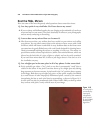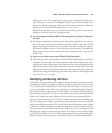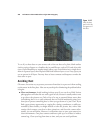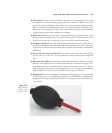Memory cards can also be stomped on, accidentally bent, dropped into the ocean,
chewed by pets, and otherwise rendered unusable in myriad ways. It’s also possible to
force a Secure Digital card into your D7000’s Secure Digital card slot incorrectly if you’re
diligent enough, doing little damage to the card itself, but bending the connector pins
in the camera, eliminating its ability to read or write to any memory card.
Or, if the card is formatted in your computer with a memory card reader, your D7000
may fail to recognize it. Occasionally, I’ve found that a memory card used in one cam-
era would fail if used in a different camera (until I reformatted it in Windows, and then
again in the camera). Every once in awhile, a card goes completely bad and—seem-
ingly—can’t be salvaged.
Another way to lose images is to do commonplace things with your card at an inop-
portune time. If you remove the card from the D7000 while the camera is writing
images to the card, you’ll lose any photos in the buffer and may damage the file struc-
ture of the card, making it difficult or impossible to retrieve the other pictures you’ve
taken. The same thing can happen if you remove the memory card from your com-
puter’s card reader while the computer is writing to the card (say, to erase files you’ve
already moved to your computer). You can avoid this by not using your computer to
erase files on a memory card but, instead, always reformatting the card in your D7000
before you use it again.
What Can You Do?
Pay attention: If you’re having problems, the first thing you should do is stop using that
memory card. Don’t take any more pictures. Don’t do anything with the card until
you’ve figured out what’s wrong. Your second line of defense (your first line is to be suf-
ficiently careful with your cards that you avoid problems in the first place) is to do no
harm that hasn’t already been done. Read the rest of this section and then, if necessary,
decide on a course of action (such as using a data recovery service or software described
later) before you risk damaging the data on your card further.
Now that you’ve calmed down, the first thing to check is whether you’ve actually inserted
a card in the camera. If you’ve set the camera so that shooting without a card has been
turned on, it’s entirely possible (although not particularly plausible) that you’ve been
snapping away with no memory card to store the pictures to, which can lead to massive
disappointment later on. Of course, the –E- warning appears on the LCD when the
camera is powered up, and the Demo message is superimposed on the review image after
every shot (assuming you’ve enabled the D7000 to take photos when a card is not
inserted), but maybe you’re inattentive, aren’t using picture review, or have purchased
one of those LCD fold-up hoods mentioned earlier in this chapter. You can avoid all
this by setting the No Memory Card? (CSM #f10) feature to Release Locked, and leav-
ing it there.
David Busch’s Nikon D7000 Guide to Digital SLR Photography474



